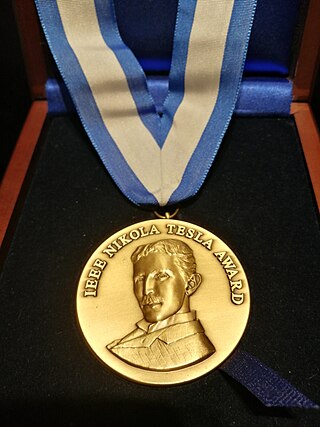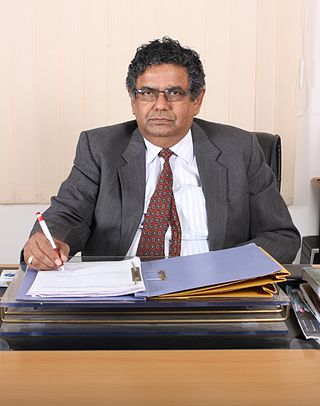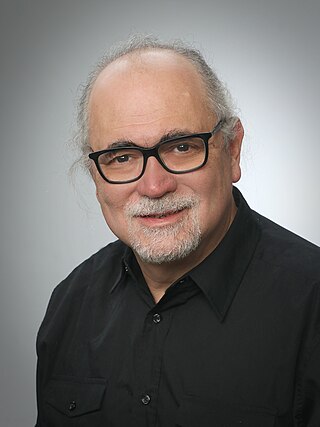Related Research Articles

Distributed generation, also distributed energy, on-site generation (OSG), or district/decentralized energy, is electrical generation and storage performed by a variety of small, grid-connected or distribution system-connected devices referred to as distributed energy resources (DER).
Electric power quality is the degree to which the voltage, frequency, and waveform of a power supply system conform to established specifications. Good power quality can be defined as a steady supply voltage that stays within the prescribed range, steady AC frequency close to the rated value, and smooth voltage curve waveform. In general, it is useful to consider power quality as the compatibility between what comes out of an electric outlet and the load that is plugged into it. The term is used to describe electric power that drives an electrical load and the load's ability to function properly. Without the proper power, an electrical device may malfunction, fail prematurely or not operate at all. There are many ways in which electric power can be of poor quality, and many more causes of such poor quality power.
A microgrid is a local electrical grid with defined electrical boundaries, acting as a single and controllable entity. It is able to operate in grid-connected and in island mode. A 'stand-alone microgrid' or 'isolated microgrid' only operates off-the-grid and cannot be connected to a wider electric power system. Very small microgrids are called nanogrids.
The Cockrell School of Engineering is one of the eighteen colleges within the University of Texas at Austin. It has more than 8,000 students enrolled in eleven undergraduate and thirteen graduate programs. Annual research expenditures are over $267 million and the school has the fourth-largest number of faculty in the National Academy of Engineering.
Electrical power system simulation involves power system modeling and network simulation in order to analyze electrical power systems using design/offline or real-time data. Power system simulation software's are a class of computer simulation programs that focus on the operation of electrical power systems. These types of computer programs are used in a wide range of planning and operational situations for electric power systems.

The IEEE Nikola Tesla Award is a Technical Field Award given annually to an individual or team that has made an outstanding contribution to the generation or utilization of electric power. It is awarded by the Board of Directors of the IEEE. The award is named in honor of Nikola Tesla. This award may be presented to an individual or a team.

The smart grid is an enhancement of the 20th century electrical grid, using two-way communications and distributed so-called intelligent devices. Two-way flows of electricity and information could improve the delivery network. Research is mainly focused on three systems of a smart grid – the infrastructure system, the management system, and the protection system. Electronic power conditioning and control of the production and distribution of electricity are important aspects of the smart grid.

Dr. Mohammad Shahidehpour is a Carl Bodine Distinguished Professor and Chairman in the Electrical and Computer Engineering Department at Illinois Institute of Technology. He is the author of more than 300 technical papers and five books on electric power systems planning, operation, and control.
The IEEE Power & Energy Society, formerly the IEEE Power Engineering Society, is the oldest society of the Institute of Electrical and Electronics Engineers (IEEE) focused on the scientific and engineering knowledge about electric power and energy.

Dwarkadas Prahladadas Kothari is an educationist and professor who has held leadership positions at engineering institutions in India including IIT Delhi, Visvesvaraya National Institute of Technology, Nagpur and VIT University, Vellore. Currently, He is with Electrical Engineering Department as Hon. Adjunct Professor. As a recognition of his contributions to engineering education, he was honoured as an IEEE Fellow. Previously he was Vice-Chancellor at VIT University.. On his 75th Birthday (07.10.2019), he was given the title of "Electrical Professor" by all his research scholars, faculty and well-wishers and a personal website of him was launched titled www.electricalprofessor.comArchived 6 October 2019 at the Wayback Machine. The 75th birthday also marks his 50 years of professional experience.
Mohamed (Mo) El-Aref El-Hawary, was an Egyptian-born Canadian scientist of electric power system studies and the involvement of traditional/modern optimization algorithms, fuzzy systems, and artificial neural networks in their applications. El-Hawary was a mathematician, electrical engineer, computational intelligence researcher and professor of electrical and computer engineering at Dalhousie University.

Diana Marculescu is the Department Chair and Motorola Regents Chair in Electrical and Computer Engineering #2 at the University of Texas at Austin. She was formerly the David Edward Schramm Professor of Electrical and Computer Engineering at Carnegie Mellon University. She is the first female chair in the department's history.
Daniel Douglas Sabin from Danvers, Massachusetts, USA was named Fellow of the Institute of Electrical and Electronics Engineers (IEEE) in 2016 for leadership in power quality database management and analysis software. He was a principal engineer with Electrotek Concepts when he was elevated to Fellow.

Marcelo Godoy Simões is a Brazilian-American scientist engineer, professor in Electrical Engineering in Flexible and Smart Power Systems, at the University of Vaasa. He was with Colorado School of Mines, in Golden, Colorado, for almost 21 years, where he is a Professor Emeritus. He was elevated to Fellow of the Institute of Electrical and Electronics Engineers (IEEE) for applications of artificial intelligence in control of power electronics systems.
Ambrish Chandra is an electrical engineer at the Ecole de Technologie Superiere in Montreal, Quebec. Chandra was named a Fellow of the Institute of Electrical and Electronics Engineers (IEEE) in 2014 for his contributions to power distribution and renewable energy systems.
Kiruba Sivasubramaniam Haran is an American engineer and professor. He is the Grainger Endowed Director's Chair in Electric Machinery and Electromechanics in the Department of Electrical and Computer Engineering at the University of Illinois at Urbana-Champaign. He also serves as the Director of the POETS Engineering Research Center, funded by the National Science Foundation (NSF), and is the Director of the Grainger Center for Electric Machinery and Electromechanics (CEME). Haran leads a research group focused on electrical machines at the University of Illinois. He is the founder and the Chief Technology Officer of Hinetics, a clean energy aviation start-up.

Dan Mircea Ionel is Professor of electrical engineer, the L. Stanley Pigman Chair in Power, and the Director of the SPARK Laboratory and of the PEIK Institute at the University of Kentucky, Lexington, KY. Professor Ionel's research includes the electric machines, wind turbines, power system, applications of power electronics, smart buildings. By the number of citations, he is among the world top 2% highly cited researchers.
Chanan Singh is an Indian-American electrical engineer and professor in the department of electrical and computer engineering, Texas A&M University. He was named Irma Runyon Chair Professor and Texas A&M System Regents Professor.
Ross Baldick is an American professor emeritus of electrical and computer engineering at the University of Texas at Austin. He is an Institute of Electrical and Electronics Engineers (IEEE) fellow of power and energy society. He is the chairman of the System Economics Sub-Committee of the IEEE Power Engineering and an associate editor of IEEE Transactions on Power Systems.
References
- 1 2 "Directory." Department of Electrical Engineering, University of Texas at Austin. University of Texas at Austin, n.d. Web. 27 Feb. 2013. <http://www.ece.utexas.edu/directory/directory_details.cfm?id=141>.
- ↑ "Power Quality – From Lightning and Harmonics To Variable Energy Resources." IEEE Power & Energy Society (PES). Proc. of 2012 General Meeting of IEEE Power & Energy Society (PES), San Diego. IEEE Power & Energy Society (PES), n.d. Web. 27 Feb. 2013. <http://pes-gm.org/2012/index.php/meeting-overview>.
- ↑ "Answer Modules." Dranetz. Dranetz, n.d. Web. 27 Feb. 2013. < "Dranetz - Dranetz Power Quality Analysis Software: Answer Modules". Archived from the original on 2012-07-18. Retrieved 2013-02-28.>.
- ↑ "Encore Series." Dranetz. Dranetz, n.d. Web. 27 Feb. 2013. < "Dranetz - Modular Power Monitoring System: Encore". Archived from the original on 2012-10-04. Retrieved 2013-02-28.>.
- ↑ Santoso, Surya, M. F. McGranaghan, Roger C. Dugan, and H. Wayne. Beaty. Electrical Power Systems Quality. ˜xxxœ: McGraw-Hill Professional, 2012. Print.
- ↑ Santoso, Surya. Fundamentals of Electric Power Quality. Austin, TX: Published by Surya Santoso, 2009. Print.
- ↑ "Surya Santoso - Google Scholar Citations." Google Scholar Citations. Google, n.d. Web. 27 Feb. 2013. <https://scholar.google.com/citations?user=Aw535JgAAAAJ>.
- ↑ "ISRN Renewable Energy. €” An Open Access Journal." ISRN Renewable Energy. €” An Open Access Journal. Hindawi Publishing Corporation, n.d. Web. 27 Feb. 2013. <http://www.hindawi.com/isrn/re/>.
- ↑ "Journal of Renewable Energy. €” An Open Access Journal." Journal of Renewable Energy. An Open Access Journal. Hindawi Publishing Corporation, n.d. Web. 27 Feb. 2013. <http://www.hindawi.com/journals/jre/>.
- ↑ "Surya Santoso." Surya Santoso. Hindawi Publishing Corporation, n.d. Web. 27 Feb. 2013. <http://www.hindawi.com/67423206/>.